Pair of Linear Equations In Two Variables
3.1 Introduction
You must have come across situations like the one given below :
Akhila went to a fair in her village. She wanted to enjoy rides on the Giant Wheel and play Hoopla (a game in which you throw a ring on the items kept in a stall, and if the ring covers any object completely, you get it). The number of times she played Hoopla is half the number of rides she had on the Giant Wheel. If each ride costs ₹ 3 , and a game of Hoopla costs ₹ 4, how would you find out the number of rides she had and how many times she played Hoopla, provided she spent ₹ 20.
May be you will try it by considering different cases. If she has one ride, is it possible? Is it possible to have two rides? And so on. Or you may use the knowledge of Class IX, to represent such situations as linear equations in two variables.

Let us try this approach.
Denote the number of rides that Akhila had by
Can we find the solutions of this pair of equations? There are several ways of finding these, which we will study in this chapter.
3.2 Graphical Method of Solution of a Pair of Linear Equations
A pair of linear equations which has no solution, is called an inconsistent pair of linear equations. A pair of linear equations in two variables, which has a solution, is called a consistent pair of linear equations. A pair of linear equations which are equivalent has infinitely many distinct common solutions. Such a pair is called a dependent pair of linear equations in two variables. Note that a dependent pair of linear equations is always consistent.
We can now summarise the behaviour of lines representing a pair of linear equations in two variables and the existence of solutions as follows:
(i) the lines may intersect in a single point. In this case, the pair of equations has a unique solution (consistent pair of equations).
(ii) the lines may be parallel. In this case, the equations have no solution (inconsistent pair of equations).
(iii) the lines may be coincident. In this case, the equations have infinitely many solutions [dependent (consistent) pair of equations].
Consider the following three pairs of equations.
(i)
(ii)
(iii)
Let us now write down, and compare, the values of
Table 3.1
| Sl No. | Pair of lines | Compare the ratios | Graphical representation | Algebraic interpretation | |||
|---|---|---|---|---|---|---|---|
| 1. | Intersecting lines | Exactly one solution (unique) | |||||
| 2. | Coincident lines | Infinitely many solutions | |||||
| 3. | Parallel lines | No solution |
From the table above, you can observe that if the lines represented by the equation
and
are
(i) intersecting, then
(ii) coincident, then
(iii) parallel, then
In fact, the converse is also true for any pair of lines. You can verify them by considering some more examples by yourself.
Let us now consider some more examples to illustrate it.
Example 1 : Check graphically whether the pair of equations
is consistent. If so, solve them graphically.
Solution : Let us draw the graphs of the Equations (1) and (2). For this, we find two solutions of each of the equations, which are given in Table 3.2
Table 3.2
| 0 | 6 | |
|---|---|---|
| 2 | 0 |
| 0 | 3 | |
|---|---|---|
| -4 | -2 |
Plot the points
We observe that there is a point B

Fig. 3.1
Example 2 : Graphically, find whether the following pair of equations has no solution, unique solution or infinitely many solutions:
Solution : Multiplying Equation (2) by
But, this is the same as Equation (1). Hence the lines represented by Equations (1) and (2) are coincident. Therefore, Equations (1) and (2) have infinitely many solutions.
Plot few points on the graph and verify it yourself.
Example 3 : Champa went to a ‘Sale’ to purchase some pants and skirts. When her friends asked her how many of each she had bought, she answered, “The number of skirts is two less than twice the number of pants purchased. Also, the number of skirts is four less than four times the number of pants purchased”. Help her friends to find how many pants and skirts Champa bought.
Solution : Let us denote the number of pants by
Let us draw the graphs of Equations (1) and (2) by finding two solutions for each of the equations. They are given in Table 3.3.
Table 3.3
| 2 | 0 | |
|---|---|---|
| 2 | -2 |
| 0 | 1 | |
|---|---|---|
| -4 | 0 |

Fig. 3.2
Plot the points and draw the lines passing through them to represent the equations, as shown in Fig. 3.2.
The two lines intersect at the point
Verify the answer by checking whether it satisfies the conditions of the given problem.
EXERCISE 3.1
1. Form the pair of linear equations in the following problems, and find their solutions graphically.
(i) 10 students of Class
(ii) 5 pencils and 7 pens together cost ₹ 50, whereas 7 pencils and 5 pens together cost ₹ 46. Find the cost of one pencil and that of one pen.
Show Answer
Solution
(i) Let the number of girls be
According to the question, the algebraic representation is
For
| 5 | 4 | 6 | |
|---|---|---|---|
| 5 | 6 | 4 |
For
| 5 | 4 | 3 | |
|---|---|---|---|
| 1 | 0 | -1 |
Hence, the graphic representation is as follows.
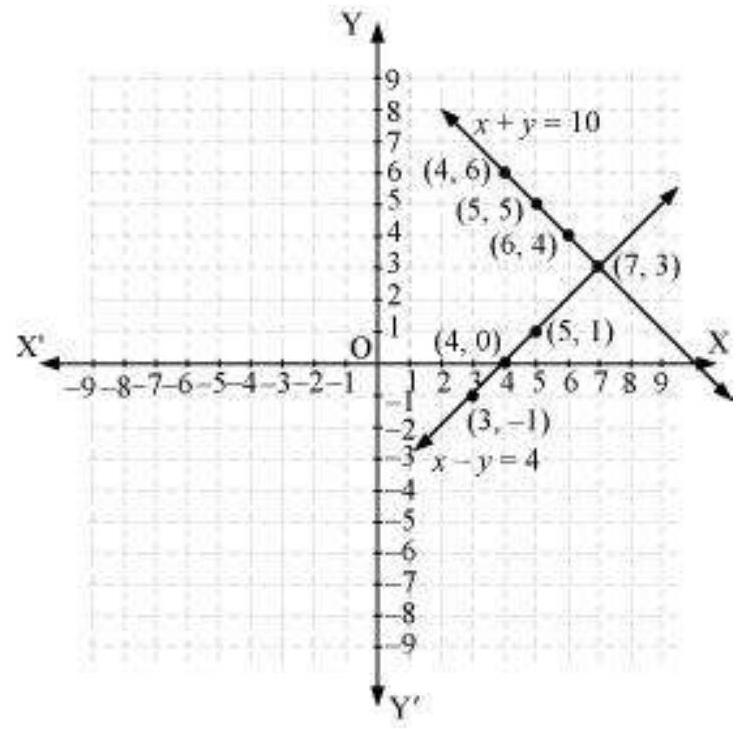
From the figure, it can be observed that these lines intersect each other at point
Therefore, the number of girls and boys in the class are 7 and 3 respectively.
(ii) Let the cost of 1 pencil be Rs
According to the question, the algebraic representation is
For
| 3 | 10 | -4 | |
|---|---|---|---|
| 5 | 0 | 10 |
| 8 | 3 | -2 | |
|---|---|---|---|
| -2 | 5 | 12 |
Hence, the graphic representation is as follows.
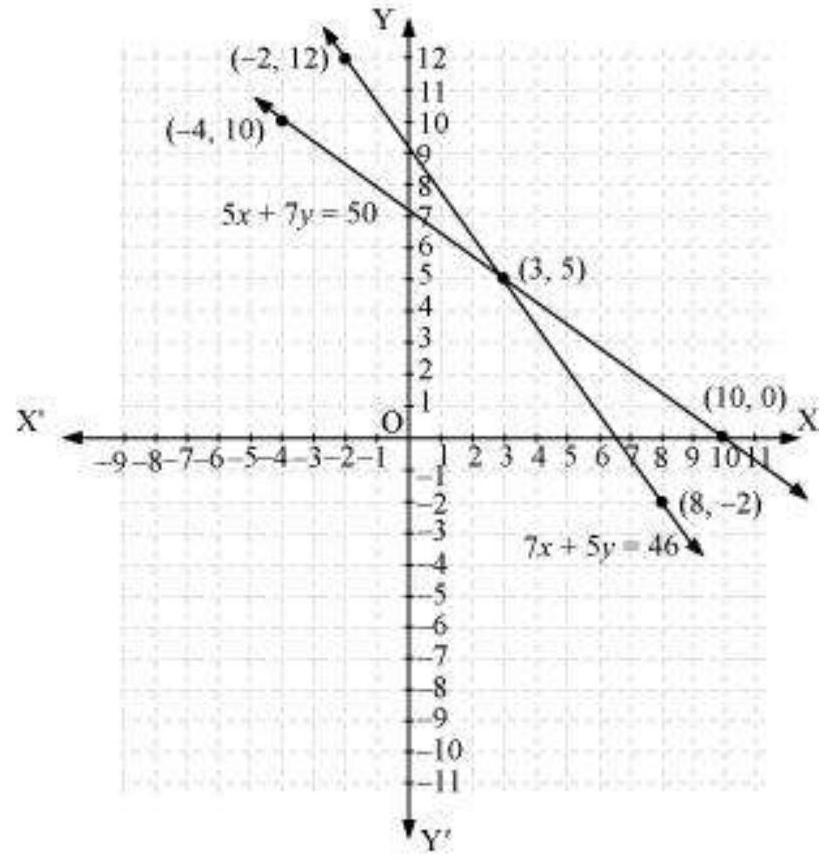
From the figure, it can be observed that these lines intersect each other at point
Therefore, the cost of a pencil and a pen are Rs 3 and Rs 5 respectively.
2. On comparing the ratios
(i)
(ii)
(iii)
Show Answer
Solution
(i)
Comparing these equations with
and
Since
Hence, the lines representing the given pair of equations have a unique solution and the pair of lines intersects at exactly one point.
(ii)
Comparing these equations with
and
Since
Hence, the lines representing the given pair of equations are coincident and there are infinite possible solutions for the given pair of equations.
(iii)
Comparing these equations with
Since
Hence, the lines representing the given pair of equations are parallel to each other and hence, these lines will never intersect each other at any point or there is no possible solution for the given pair of equations.
3. On comparing the ratios
(i)
(ii)
(iii)
(iv)
(v)
Show Answer
Solution
(i)
These linear equations are intersecting each other at one point and thus have only one possible solution. Hence, the pair of linear equations is consistent.
(ii)
Since
Therefore, these linear equations are parallel to each other and thus have no possible solution. Hence, the pair of linear equations is inconsistent.
(iii)
Since
Therefore, these linear equations are intersecting each other at one point and thus have only one possible solution. Hence, the pair of linear equations is consistent.
(iv)
Since
Therefore, these linear equations are coincident pair of lines and thus have infinite number of possible solutions. Hence, the pair of linear equations is consistent.
(v)
Since
Therefore, these linear equations are coincident pair of lines and thus have infinite number of possible solutions. Hence, the pair of linear equations is consistent.
4. Which of the following pairs of linear equations are consistent/inconsistent? If consistent, obtain the solution graphically:
(i)
(ii)
(iii)
(iv)
Show Answer
Solution
(i)
Since
Therefore, these linear equations are coincident pair of lines and thus have infinite number of possible solutions. Hence, the pair of linear equations is consistent.
| 4 | 3 | 2 | |
|---|---|---|---|
| 1 | 2 | 3 |
And,
| 4 | 3 | 2 | |
|---|---|---|---|
| 1 | 2 | 3 |
Hence, the graphic representation is as follows.
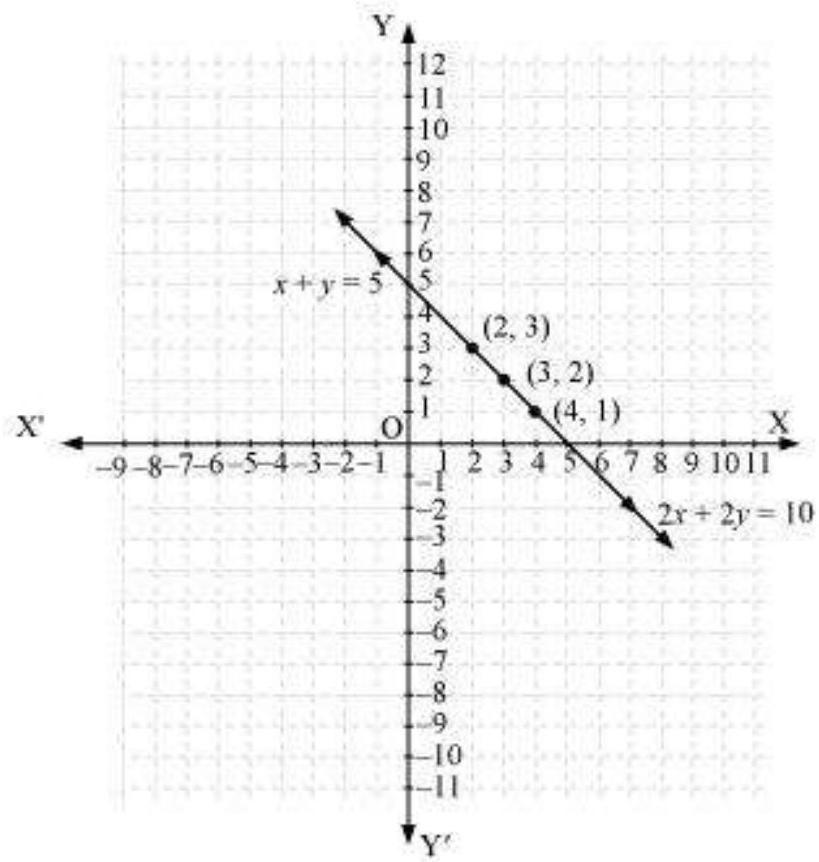
From the figure, it can be observed that these lines are overlapping each other. Therefore, infinite solutions are possible for the given pair of equations.
(ii)
Since
Therefore, these linear equations are parallel to each other and thus have no possible solution. Hence, the pair of linear equations is inconsistent.
(iii)
Since
Therefore, these linear equations are intersecting each other at one point and thus have only one possible solution. Hence, the pair of linear equations is consistent.
| 0 | 1 | 2 | |
|---|---|---|---|
| 6 | 4 | 2 |
And
| 1 |
|---|
5. Half the perimeter of a rectangular garden, whose length is
Show Answer
Solution
Let the width of the garden be
According to the question,
| 0 | 8 | 12 | |
|---|---|---|---|
| 4 | 12 | 16 |
| 0 | 36 | 16 | |
|---|---|---|---|
| 36 | 0 | 20 |
Hence, the graphic representation is as follows.
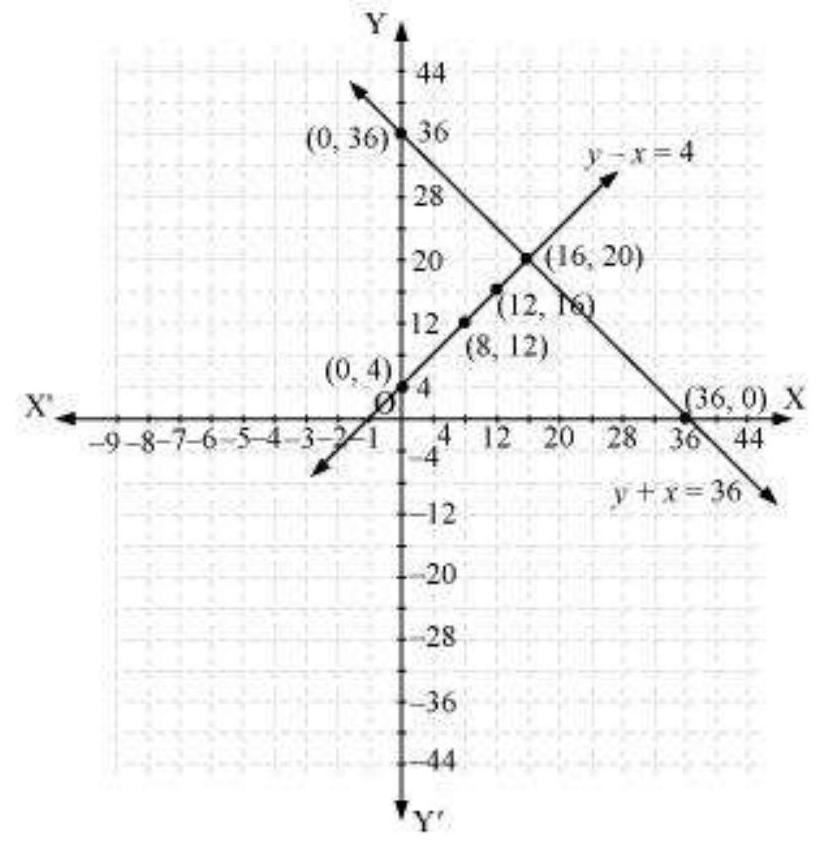
From the figure, it can be observed that these lines are intersecting each other at only point i.e., (16, 20). Therefore, the length and width of the given garden is
6. Given the linear equation
(i) intersecting lines
(ii) parallel lines
(iii) coincident lines
Show Answer
Solution
(i)Intersecting lines:
For this condition,
The second line such that it is intersecting the given line
is
(ii) Parallel lines:
For this condition,
Hence, the second line can be
as
And clearly,
(iii)Coincident lines:
For coincident lines,
Hence, the second line can be
as
And clearly,
7. Draw the graphs of the equations
Show Answer
Solution
| 0 | 1 | 2 | |
|---|---|---|---|
| 1 | 2 | 3 |
| 4 | 2 | 0 | |
|---|---|---|---|
| 0 | 3 | 6 |
Hence, the graphic representation is as follows.
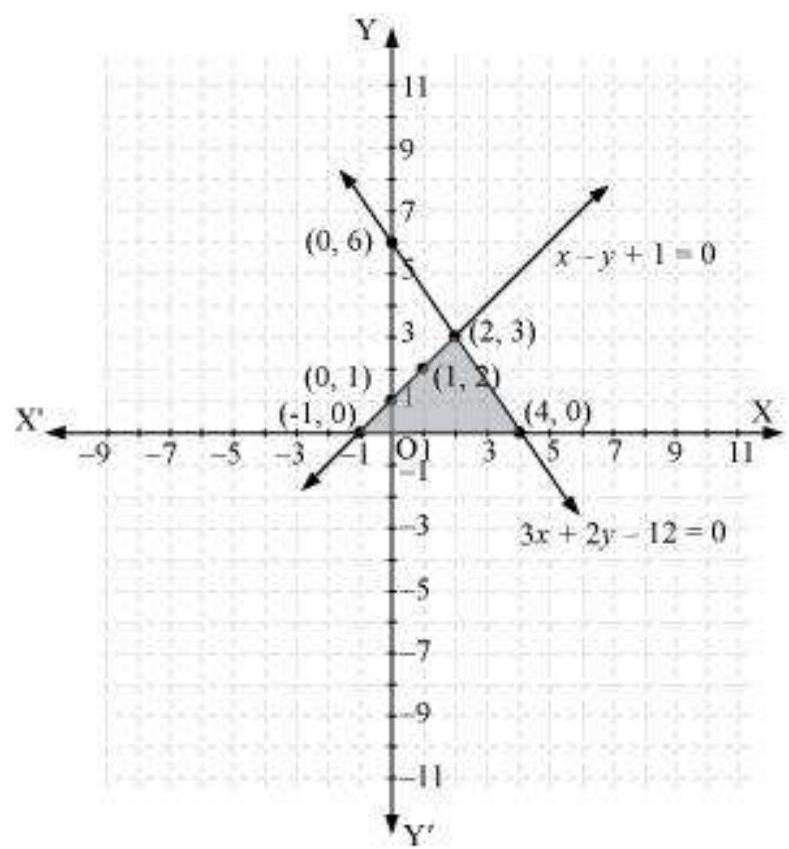
From the figure, it can be observed that these lines are intersecting each other at point
3.3 Algebraic Methods of Solving a Pair of Linear Equations
In the previous section, we discussed how to solve a pair of linear equations graphically. The graphical method is not convenient in cases when the point representing the solution of the linear equations has non-integral coordinates like
3.3.1 Substitution Method:
We shall explain the method of substitution by taking some examples.
Example 4 : Solve the following pair of equations by substitution method:
Solution :
Step 1 : We pick either of the equations and write one variable in terms of the other. Let us consider the Equation (2) :
and write it as
Step 2 : Substitute the value of
Step 3 : Substituting this value of
Therefore, the solution is
Verification : Substituting
To understand the substitution method more clearly, let us consider it stepwise:
Step 1 : Find the value of one variable, say
Step 2 : Substitute this value of
Step 3 : Substitute the value of
Remark : We have substituted the value of one variable by expressing it in terms of the other variable to solve the pair of linear equations. That is why the method is known as the substitution method.
Example 5 : Solve the following question-Aftab tells his daughter, “Seven years ago, I was seven times as old as you were then. Also, three years from now, I shall be three times as old as you will be.” (Isn’t this interesting?) Represent this situation algebraically and graphically by the method of substitution.
Solution : Let
and
Using Equation (2), we get
Putting this value of
Putting this value of
So, Aftab and his daughter are 42 and 12 years old, respectively.
Verify this answer by checking if it satisfies the conditions of the given problems.
Example 6 : In a shop the cost of 2 pencils and 3 erasers is ₹9 and the cost of 4 pencils and 6 erasers is ₹18. Find the cost of each pencil and each eraser.
Solution : The pair of linear equations formed were:
We first express the value of
Now we substitute this value of
This statement is true for all values of
Example 7 : Two rails are represented by the equations
Solution : The pair of linear equations formed were:
We express
Now, we substitute this value of
which is a false statement.
Therefore, the equations do not have a common solution. So, the two rails will not cross each other.
EXERCISE 3.2
1. Solve the following pair of linear equations by the substitution method.
Show Answer
Solution
(i)
From (1), we obtain
Substituting this value in equation (2), we obtain
Substituting this in equation (3), we obtain
(ii)
From (1), we obtain
Substituting this value in equation (2), we obtain
Substituting in equation (3), we obtain
(iii)
From (1), we obtain
Substituting this value in equation (2), we obtain
This is always true.
Hence, the given pair of equations has infinite possible solutions and the relation between these variables can be given by
Therefore, one of its possible solutions is
(iv)
From equation (1), we obtain
Substituting this value in equation (2), we obtain
Substituting this value in equation (3), we obtain
(v)
From equation (1), we obtain
Substituting this value in equation (2), we obtain
Substituting this value in equation (3), we obtain
2. Solve
Show Answer
Solution
From equation (1), we obtain
Substituting this value in equation (2), we obtain
Putting this value in equation (3), we obtain
Hence,
Also,
3. Form the pair of linear equations for the following problems and find their solution by substitution method.
(i) The difference between two numbers is 26 and one number is three times the other. Find them.
(ii) The larger of two supplementary angles exceeds the smaller by 18 degrees. Find them.
(iii) The coach of a cricket team buys 7 bats and 6 balls for ₹ 3800. Later, she buys 3 bats and 5 balls for ₹ 1750 . Find the cost of each bat and each ball.
(iv) The taxi charges in a city consist of a fixed charge together with the charge for the distance covered. For a distance of
(v) A fraction becomes
(vi) Five years hence, the age of Jacob will be three times that of his son. Five years ago, Jacob’s age was seven times that of his son. What are their present ages?
Show Answer
Solution
(i) Let the first number be
According to the given information,
On substituting the value of
Substituting this in equation (1), we obtain
Hence, the numbers are 13 and 39.
(ii) Let the larger angle be
We know that the sum of the measures of angles of a supplementary pair is always
According to the given information,
From (1), we obtain
Substituting this in equation (2), we obtain
Putting this in equation (3), we obtain
Hence, the angles are
(iii) Let the cost of a bat and a ball be
According to the given information,
From (1), we obtain
Substituting this value in equation (2), we obtain
Substituting this in equation (3), we obtain
Hence, the cost of a bat is Rs 500 and that of a ball is Rs 50 .
(iv) Let the fixed charge be Rs
According to the given information,
From (1), we obtain
Substituting this in equation (2), we obtain
Putting this in equation (3), we obtain
Hence, fixed charge
And per km charge
Charge for
(v) Let the fraction be
According to the given information,
From equation (1), we obtain
3.3.2 Elimination Method
Now let us consider another method of eliminating (i.e., removing) one variable. This is sometimes more convenient than the substitution method. Let us see how this method works.
Example 8 : The ratio of incomes of two persons is
Solution : Let us denote the incomes of the two person by ₹
and
Step 1 : Multiply Equation (1) by 3 and Equation (2) by 4 to make the coefficients of
Step 2 : Subtract Equation (3) from Equation (4) to eliminate y, because the coefficients of
Step 3 : Substituting this value of
So, the solution of the equations is
Verification :
Remarks :
1. The method used in solving the example above is called the elimination method, because we eliminate one variable first, to get a linear equation in one variable.
In the example above, we eliminated
2. You could also have used the substitution, or graphical method, to solve this problem. Try doing so, and see which method is more convenient.
Let us now note down these steps in the elimination method :
Step 1 : First multiply both the equations by some suitable non-zero constants to make the coefficients of one variable (either
Step 2 : Then add or subtract one equation from the other so that one variable gets eliminated. If you get an equation in one variable, go to Step 3.
If in Step 2, we obtain a true statement involving no variable, then the original pair of equations has infinitely many solutions.
If in Step 2, we obtain a false statement involving no variable, then the original pair of equations has no solution, i.e., it is inconsistent.
Step 3 : Solve the equation in one variable (
Step 4 : Substitute this value of
Now to illustrate it, we shall solve few more examples.
Example 9 : Use elimination method to find all possible solutions of the following pair of linear equations :
Solution :
Step 1 : Multiply Equation (1) by 2 and Equation (2) by 1 to make the coefficients of
Step 2 : Subtracting Equation (4) from Equation (3),
Therefore, the pair of equations has no solution.
Example 10 : The sum of a two-digit number and the number obtained by reversing the digits is 66 . If the digits of the number differ by 2 , find the number. How many such numbers are there?
Solution : Let the ten’s and the unit’s digits in the first number be
When the digits are reversed,
According to the given condition.
We are also given that the digits differ by 2 , therefore,
either
or
If
In this case, we get the number 42.
If
In this case, we get the number 24.
Thus, there are two such numbers 42 and 24.
Verification : Here
EXERCISE 3.3
1. Solve the following pair of linear equations by the elimination method and the substitution method:
(i)
(ii)
(iii)
(iv)
Show Answer
Solution
(i) By elimination method
Multiplying equation (1) by 2 , we obtain
Subtracting equation (2) from equation (3), we obtain
Substituting the value in equation (1), we obtain
By substitution method
From equation (1), we obtain
Putting this value in equation (2), we obtain
Substituting the value in equation (5), we obtain
(ii) By elimination method
Multiplying equation (2) by 2 , we obtain
Adding equation (1) and (3), we obtain
Substituting in equation (1), we obtain
Hence,
By substitution method
From equation (2), we obtain
Putting this value in equation (1), we obtain
Substituting the value in equation (5), we obtain
(iii) By elimination method
2. Form the pair of linear equations in the following problems, and find their solutions (if they exist) by the elimination method :
(i) If we add 1 to the numerator and subtract 1 from the denominator, a fraction reduces to 1 . It becomes
(ii) Five years ago, Nuri was thrice as old as Sonu. Ten years later, Nuri will be twice as old as Sonu. How old are Nuri and Sonu?
(iii) The sum of the digits of a two-digit number is 9 . Also, nine times this number is twice the number obtained by reversing the order of the digits. Find the number.
(iv) Meena went to a bank to withdraw ₹ 2000. She asked the cashier to give her ₹ 50 and ₹ 100 notes only. Meena got 25 notes in all. Find how many notes of ₹
(v) A lending library has a fixed charge for the first three days and an additional charge for each day thereafter. Saritha paid ₹ 27 for a book kept for seven days, while Susy paid ₹ 21 for the book she kept for five days. Find the fixed charge and the charge for each extra day.
Show Answer
Solution
(i)Let the fraction be
According to the given information,
Subtracting equation (1) from equation (2), we obtain
Substituting this value in equation (1), we obtain
Hence, the fraction is
(ii) Let present age of Nuri
and present age of Sonu
According to the given information,
Subtracting equation (1) from equation (2), we obtain
Substituting it in equation (1), we obtain
Hence, age of Nuri
And, age of Sonu
(iii) Let the unit digit and tens digits of the number be
Number after reversing the digits
According to the given information,
Adding equation (1) and (2), we obtain
Substituting the value in equation (1), we obtain
Hence, the number is
(iv)Let the number of Rs 50 notes and Rs 100 notes be
According to the given information,
Multiplying equation (1) by 50 , we obtain
Subtracting equation (3) from equation (2), we obtain
Substituting in equation (1), we have
Hence, Meena has 10 notes of Rs 50 and 15 notes of Rs 100.
(v)Let the fixed charge for first three days and each day charge thereafter be Rs
According to the given information,
Subtracting equation (2) from equation (1), we obtain
Substituting in equation (1), we obtain
Hence, fixed charge
And Charge per day
3.4 Summary
In this chapter, you have studied the following points:
1. A pair of linear equations in two variables can be represented, and solved, by the:
(i) graphical method
(ii) algebraic method
2. Graphical Method :
The graph of a pair of linear equations in two variables is represented by two lines.
(i) If the lines intersect at a point, then that point gives the unique solution of the two equations. In this case, the pair of equations is consistent.
(ii) If the lines coincide, then there are infinitely many solutions - each point on the line being a solution. In this case, the pair of equations is dependent (consistent).
(iii) If the lines are parallel, then the pair of equations has no solution. In this case, the pair of equations is inconsistent.
3. Algebraic Methods : We have discussed the following methods for finding the solution(s) of a pair of linear equations :
(i) Substitution Method
(ii) Elimination Method
4. If a pair of linear equations is given by
(i)
(ii)
(iii)
5. There are several situations which can be mathematically represented by two equations that are not linear to start with. But we alter them so that they are reduced to a pair of linear equations.






